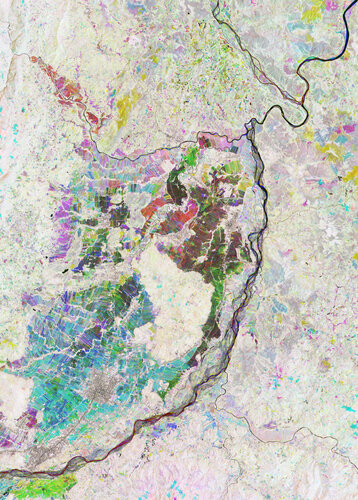The heart of the Nueva Vizcaya Province on Luzon, the largest and most populated island of the Philippines, shows up brightly in this Copernicus Sentinel-2 false-colour image.
Zoom in to explore this image at its full 10 m resolution or click on the circles to learn more.
The colours in the image are due to it being a multitemporal composite, made up of three Copernicus Sentinel-2 images acquired with the mission’s near-infrared channel over a period of 10 months. Different colours have been assigned to each acquisition: red to an acquisition in May 2022 during the hot dry season, green to one in September 2022 during the wet season, and blue to one in March 2023 in the cool dry season.
This combination highlights different features, such as crop types, and changes that occurred between acquisitions which show the different growth stages.
A patchwork of colourful agricultural fields stand out in the centre to bottom left of the image. Areas in shades of red and green mean that the plant growth took place in May and September respectively. Fields visible in shades of blue, which dominate the image, show that the plant growth occurred mainly in March during the cool dry season.
Most fields are left waterlogged all year round, probably for intensive rice production, with canals between them. Bright white areas, as in the middle of the fields, indicate zones covered with dense vegetation.
Straight lines and areas in grey depict roads and urban areas. These include Solano, the largest town in Nueva Vizcaya, visible in the bottom left surrounded by blue fields, and further south is Bayombong, the capital of the province.
The dark winding lines depict rivers, with the biggest, Magat River, flowing in a north-easterly direction across the image. Taking a closer look, different colours can be spotted along the course of the rivers. This is most likely due to changes in water volume and in the river paths at different times of the year.
With its 13 spectral channels, Copernicus Sentinel-2 is designed to provide data that can be used to map and monitor croplands and the mission’s frequent revisits over the same area and high spatial resolution allow changes in inland water bodies to be closely monitored.
In January 2023, ESA and the European Commission signed an agreement to build a Copernicus mirror site in the Philippines – the first of its kind in southeast Asia. This new initiative will enhance the response capability and resilience of the Philippines to natural and human-made disasters through the strategic use of space data.



 Image:
The heart of the Nueva Vizcaya Province on Luzon, the largest and most populated island of the Philippines, shows up brightly in this Copernicus Sentinel-2 false-colour image.
Image:
The heart of the Nueva Vizcaya Province on Luzon, the largest and most populated island of the Philippines, shows up brightly in this Copernicus Sentinel-2 false-colour image.